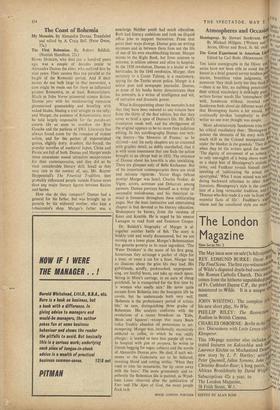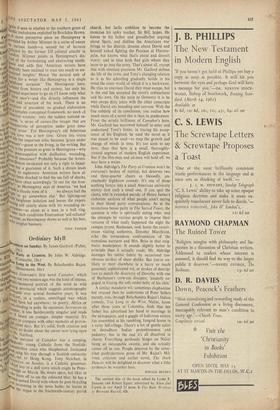Atmospheres and OccasioP Go t h ic Hemingway. By Stewart Sanderson. Falp 1 , _, 111
THE latest monographs in the Oliver arid:1 ienee series have not been able to avoid the r' :neic rall 1sQl herent in a brief general survey (endless Plol marics, breathless value judgments, is,. on moreover 'they think justly but they thinkl —there is no bite, no stabbing penetration' their critical vocabulary is strikingly poorcii13,ersonz: writers favour words like 'atmosphere' (f4,1 have with, Sanderson without, inverted cooljVIYIe Sanderson finds about six different ways of Tecreti( that Hemingway leaves a lot unsaid, MI; ?! a co continually invokes 'complexity' to deg° 'llherit( writer no one ever thought was simple. 4ieusPkohse, More adventurously Sanderson tries to 6' aract his critical vocabulary thus: 'HemingvvaYn"al pulates the elements of his story with f°1" n's,ach t 7 li much skill as the Colonel manipulates gh0fe under the blanket in the gondola.' They do 41,ssur when they let the writers speak for theolsclibuY is The dignity of movement of an iceberg is e pr, to only one-eighth of it being above watcr.,„gii:ss of us a sharp hint of Hemingway's stylistic 1" 'an Dr tions; and Faulkner reveals himself clearifi,ess bt speaking of 'sublimating the actual int°10,4-4silY • apocryphal.' What I most missed was WV c, aYs b dating backward reference to other Aotot"irld ha literature. Hemingway's style is the consn'"IL'er': lion of a long vernacular tradition, and tt i;:a0e a Thoreau who first made it a rule `to front olgo101 t essential facts of life': Faulkner's attfrl,,n1Y h vision and his castellated style are more to °Icing • -1/ nligible if seen in relation to the southern genre of 510n "othic melodrama exploited by Brockden Brown. F i pyk more perceptive piece on Hemingway is rid k.ovided by Arthur Mizener in a series of essays acbl Various hands—a second lot of lectures Lit i_uollected by the former US cultural' attaché in 151111.,,n_don. Mizener points to Hemingway's dis-
,, Lust of the formulating and abstracting intelli-
a au4 et1C
e and adds that 'American writers have
riff 6nernii fir - Y been inclined to trust too much to un- pin. analysed insights.' , H
nsig ts. Hence 'the natural unit of
s5110(1 for a writer like Hemingway is a single Anificant occasion.' The Hemingway hero,
died from history and society, has only his nor., personal experience to go on ('I know only what
have seen)—and this directly influences the c°,1311,Yie and structure of his work. There is no s °"14,,e;crelion of precedent, no gradual elaboration PriniV'in'ila Complex conceptual framework, no stock of iesc." erited wisdom: only the sudden isolated re- dic'i-1"se, 'a series of cameo-like images that are to c't. aracteristic of perception under great emo- ,vaY 111„, ,I°11a1 stress' For Hemingway's old fisherman h fw"loetach time was a new time. Given this vision es geb°0,,, life the important ethic becomes 'grace under do ilit'essilre'—grace in the living, in the writing. But hat hi)" is the pressure so great in Hemingway—why erg e Preoccupation with disillusion, wounding, ater‘,10:38s of innocence? Probably because the Amer-- stic 'L11°1 bream inculcated not only a right to happi- clear" le,,es but a guarantee of it. Such a dream leads iat°10A`"silY to nightmare. American writers have al- anY aYs been shocked to find the sea full of sharks, AincLond have often accordingly lit out for the fron- onsu"'-er': as Hemingway says of America. 'we had [rid made a bloody mess of it . . . we always had the [it on501 to go somewhere else.' But lighting-out ankloiehn'Y, heightens isolation and leaves the experi- 100 p,e'rig self utterly alone with his wounding ex- Vriellees—as alone as a man in a bull ring. nd be er such conditions Emersonian 'self-reliance' afar as Hemingway shows so well at his best,
tougher business.
TONY TANNER-







































 Previous page
Previous page